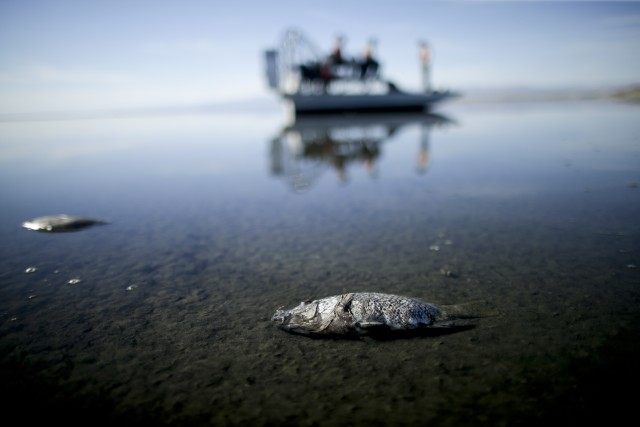California’s largest lake, the Salton Sea, continues to disappear amidst the state’s devastating four-year-long drought.
According to a disturbing new report from the Associated Press, the slow recession of the Salton Sea is causing mass wildlife die-offs, air pollution problems and concerns over whether the state of California is holding up its end of a deal completed nearly a decade ago to restore the lake.
The Salton Sea’s immediate problem is water availability; there is simply not enough water to go around as the state grapples with a fourth year of an historic drought. The lake, situated mainly in the Imperial and Coachella Valleys, is a casualty of water diversion to urban cities like nearby San Diego.
San Diego reportedly takes more than one-quarter of its water supply from the Imperial Valley, where fields produce runoff that make up roughly 7o percent of the Salton Sea’s inflow. As San Diego and other coastal cities buy more water to battle the drought, the lake is literally being left in the dust.
The nonprofit Pacific Institute predicts that the surface area of the lake will recede by 100 square miles by 2030, according to the AP. Estimates call for a tripling in the lake’s salinity levels within 15 years and the complete extinction of the lake’s fish in just seven years if nothing is done to help restore it.
“We’re kind of between a rock and a hard spot,” area farmer Al Kalin told the AP. “We’ve got to conserve water for the thirsty people, 17 million in Southern California. At the same time, there’s concern about the Salton Sea because it’s rapidly declining because of our conservation efforts.”
As part of San Diego’s water purchase agreement with the Imperial Valley in 2003, the San Diego County Water Authority promised to provide water to the lake while the state came up with a long-term solution, but a long-term plan remains stubbornly out of reach. In March 2012, the state Supreme Court voted to uphold the water deal, which will send about 200,000 acre-feet of water from Imperial Valley farmers to San Diego by 2021.
The effects on the Salton Sea and the surrounding communities are dire. In 2013, a Vice News reporter described the lake as “something of an ecological nightmare soup:”
The water is a murky brown—it only appears blue because it reflects the desert sky. The white beaches, it turns out, are white because they’re made up of the pulverized bones of millions of dead fish. The birds probably aren’t doing too well, either. Avian botulism is a persistent problem in the Salton Sea, killing off thousands of birds each year.
Another problem is the smell; according to the AP, strong winds bring hydrogen sulfide gas from the bottom of the lake to the top, creating a nasty stench. At one point, the odor was reportedly so bad that it carried 150 miles away to Los Angeles.
“Unfortunately, that’s the only time anyone will listen because we don’t have a voice,” Salton City resident Julie Londo, sitting on her porch just a short distance away from the water, told the AP. “You can scream all you want. Nobody cares.”

COMMENTS
Please let us know if you're having issues with commenting.